Artemisia Gentileschi (1593 – 1653)
Get a Gentileschi Certificate of Authenticity for your painting (COA) for your Gentileschi drawing.
For all your Gentileschi artworks you need a Certificate of Authenticity (COA) in order to sell, to insure or to donate for a tax deduction.
Getting a Gentileschi Certificate of Authenticity (COA) is easy. Just send us photos and dimensions and tell us what you know about the origin or history of your Gentileschi painting or drawing.
If you want to sell your Gentileschi painting or drawing use our selling services. We offer Gentileschi selling help, selling advice, private treaty sales and full brokerage.
We have been authenticating Gentileschi and issuing certificates of authenticity since 2002. We are recognized Gentileschi experts and Gentileschi certified appraisers. We issue COAs and appraisals for all Gentileschi artworks.
Our Gentileschi paintings and drawings authentications are accepted and respected worldwide.
Each COA is backed by in-depth research and analysis authentication reports.
The Gentileschi certificates of authenticity we issue are based on solid, reliable and fully referenced art investigations, authentication research, analytical work and forensic studies.
We are available to examine your Gentileschi painting or drawing anywhere in the world.
You will generally receive your certificates of authenticity and authentication report within two weeks. Some complicated cases with difficult to research Gentileschi paintings or drawings take longer.
Our clients include Gentileschi collectors, investors, tax authorities, insurance adjusters, appraisers, valuers, auctioneers, Federal agencies and many law firms.
We perform Artemisia Gentileschi art authentication. appraisal, certificates of authenticity (COA), analysis, research, scientific tests, full art authentications. We will help you sell your Artemisia Gentileschi or we will sell it for you.

Artemesia Gentileschi was an Italian Early Baroque painter, today considered one of the most accomplished painters in the generation influenced by Caravaggio (Caravaggisti). In an era when women painters were not easily accepted by the artistic community, she was the first female painter to become a member of the Accademia di Arte del Disegno in Florence. She was also one of the first female artists to paint historical and religious paintings, at a time when such heroic themes were considered beyond a woman’s reach.
Gentileschi was born in Rome, on July 8, 1593, the first child of the painter Orazio Gentileschi, one of the greatest representatives of the school of Caravaggio. Artemisia was introduced to painting in her father’s workshop, showing much more talent than her brothers, who worked alongside her. She learned drawing, how to mix color and how to paint. Since her father’s style took inspiration from Caravaggio during that period, her style was just as heavily influenced in turn. But her approach to subject matter was different from her father’s.
The first work of the young 18-year-old Artemisia (even if many at the time suspected that she was helped by her father) was the Susanna e i Vecchioni (Susanna and the Elders) (1610, Schönborn collection in Pommersfelden). The picture shows how Artemisia assimilated the realism of Caravaggio without being indifferent to the language of the Bologna school (which had Annibale Carracci among its major artists).
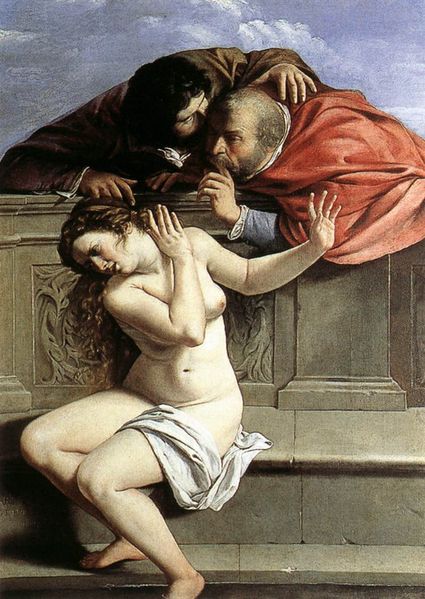
In 1612, despite her early talent, Artemisia was denied access to the all-male professional academies for art. At the time, her father was working with Agostino Tassi to decorate the vaults of Casino della Rose inside the Pallavicini Rospigliosi Palace in Rome, so Orazio hired the Tuscan painter to tutor his daughter privately. During this tutelage, Tassi raped Artemisia. Even though Tassi initially promised to marry Artemisia in order to restore her reputation, he later reneged on his promise and Orazio reported Tassi to the authorities.
In the ensuing 7-month trial, it was discovered that Tassi had planned to murder his wife, had enjoined in adultery with his sister-in-law and planned to steal some of Orazio’s paintings. During the trial Artemisia was given a gynecological examination and was tortured using a device made of thongs wrapped around the fingers and tightened by degrees — a particularly cruel torture to a painter. Both procedures were used to corroborate the truth of her allegation, the torture device used due to the belief that if a person can tell the same story under torture as without it, the story must be true. At the end of the trial Tassi was imprisoned for one year. The trial has subsequently influenced the feminist view of Artemisia Gentileschi during the late 20th century.
The painting Giuditta che decapita Oloferne (Judith beheading Holofernes) (1612 – 1613), displayed in the Capodimonte Museum of Naples, is impressive for the violence portrayed, and has been interpreted as a wish for psychological revenge for the violence Artemisia had suffered.
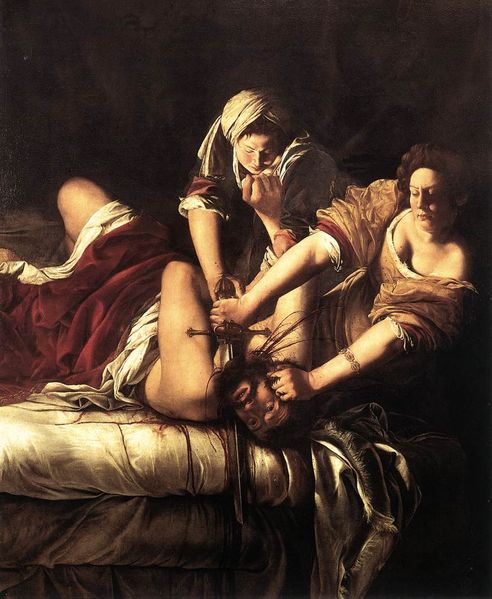
One month after the trial, in order to restore her honor, Orazio arranged for his daughter to marry Pierantonio Stiattesi, a modest artist from Florence. Shortly afterwards the couple moved to Florence, where Artemisia received a commission for a painting at Casa Buonarroti and became a successful court painter, enjoying the patronage of the Medici and Charles I. It has been proposed that during this period Artemisia also painted the Madonna col Bambino (The Virgin and Child), currently in the Spada Gallery, Rome.
While in Florence, Artemisia and Pierantonio had four sons and one daughter. But only the daughter, Prudenzia, survived to adulthood — following her mother’s return to Rome in 1621 and later move to Naples. After her mother’s death in 1651, Prudenzia slipped into obscurity and little is known of her subsequent life.

In Florence, Artemisia enjoyed huge success. She was the first woman accepted into the Accademia del Disegno (Academy of Drawing). She maintained good relations with the most respected artists of her time, such as Cristofano Allori, and to be able to conquer the favours and the protection of influential people, starting with Granduke Cosimo II de’ Medici and especially of the Granduchess Cristina. She had a good relationship with Galileo Galilei with whom she remained in epistolary contact for a long time. She was esteemed by Michelangelo Buonarroti the younger (nephew of the great Michelangelo): busy with construction of Casa Buonarroti to celebrate his notable relative, he asked Artemisia to produce a painting to decorate the ceiling of the gallery of paintings.
The painting represents an allegory of Allegoria dell’Inclinazione (Allegory of the Inclination) (natural talent), presented under the form of a young nude woman who holds a compass. It is believed that the subject bears a resemblance to Artemisia. Indeed, in several of her paintings, Artemisia’s energetic heroines have a similar appearance to her self-portraits. Her success and gender fuelled many rumors about her private life.
Notable works from this period include La Conversione della Maddalena (The Conversion of the Magdalene), and Giuditta con la sua ancella (Judith and her Maidservant), now in the Pitti Palace. Artemisia painted a second version of Giuditta che decapita Oloferne (Judith beheading Holofernes), this one larger than the Naples version and now housed in the Uffizi Gallery of Florence.

Despite her success, due to an excess of expenses by her and her husband, the Florentine period was full of problems with creditors and with her husband. These problems lead to her return to Rome in 1621.
Artemisia arrived in Rome the same year her father Orazio departed for Genoa. Some believe that Artemisia followed her father there; while there is not enough evidence for this, this time together would have accentuated the similarity of their styles, which makes it often difficult today to determine which of the two painted certain works. Most of the evidence supports the notion that Artemisia remained in Rome, trying to find a home and raise her daughters. In addition to Prudenzia (born from the marriage with Pierantonio Stiattesi) she had another natural daughter, probably born in 1627. Artemisia tried, with almost no success, to teach them the art of painting.
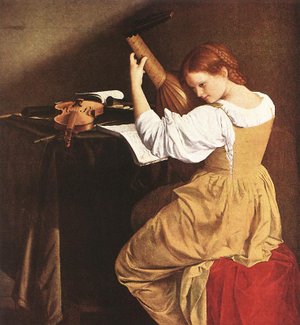
Caravaggio’s style, though the master had been dead over a decade, was still highly influential and converted many painters to his style (the so-called Caravaggisti) such as Artemisia’s father, Carlo Saraceni (who returned to Venice 1620), Bartolomeo Manfredi, and Simon Vouet. However, painting styles in Rome during the early 17th century were diverse, a more classic manner of the Bolognese disciples of the Carracci and the baroque style of Pietro da Cortona.
It appears that Artemisia was also associated the Academy of the Desiosi. She was celebrated with a portrait carrying the incision “Pincturare miraculum invidendum facilius quam imitandum”. In the same period she became friends with Cassiano dal Pozzo, a humanist, collector and lover of arts. However, despite her artistic reputation, her strong personality and her numerous good relationships, Rome was not as lucrative as she hoped. The appreciation of her art was narrowed down to portraits and to her ability with biblical heroines: she received none of the lucrative commissions for altarpieces. The absence of sufficient documentation makes it difficult to follow Artemisia’s movements in this period. It is certain that between 1627 and as late as 1630 she moved to Venice, perhaps in search of richer commissions, as verses and letters were composed in appreciation of her and her works in Venice.
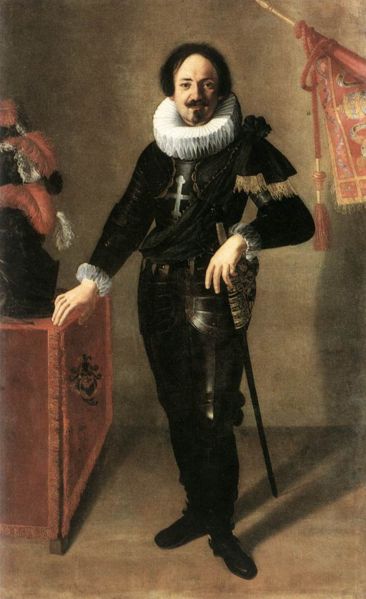
Although it is sometimes difficult to date her paintings, it is possible to assign to her these years the Ritratto di gonfaloniere (Portrait of Gonfaloniere), today in Bologna (a rare example of her capacity as portrait painter); the Giuditta con la sua ancella, (Judith and her Maidservant) today housed at the Detroit Institute of Arts. The Detroit painting is notable for her mastery of chiaroscuro and tenebrism (the effect of extreme lights and darks), techniques for which Gerrit van Honthorst, Trophime Bigot, and many others in Rome were famous. Her Venere Dormiente (The Sleeping Venus), today at Virginia Museum of Fine Arts, Richmond, and her Ester ed Assuero (Esther and Ahasuerus) located at the Metropolitan Museum of Art in New York, are testimony of her assimilation of the lessons of Venetian luminism.
In 1630 Artemisia moved to Naples, a city rich with workshops and art lovers, in search of new and more lucrative job opportunities. Many other artists, including Caravaggio, Annibale Carracci, Simon Vouet had stayed in Naples for some time in their lives, and at that time, Jusepe de Ribera, Massimo Stanzione, and Domenichino were working there and later, Giovanni Lanfranco and many others would flock to the city. The Neapolitan debut of Artemisia is represented by the Annunciation in the Capodimonte Museum. She remained in Naples for the remaineder of her career with the exception of a brief trip to London and some other journeys. Naples was for Artemisia a kind of second homeland where she took care of her family (both her daughters were married in Naples). She received letters of appreciation, being in good relations with the viceroy the Duke of Alcalá and started relations with many renowned artists, among them Massimo Stanzione, with whom, the eighteenth-century writer Bernardo de’ Dominici reports, she started an artistic collaboration based on a real friendship and artistic similarities.

In Naples for the first time Artemisia started working on paintings in a cathedral, dedicated to San Gennaro nell’anfiteatro di Pozzuoli (Saint Januarius in the amphitheater of Pozzuoli) in Pozzuoli. During her first Neapolitan period she painted Nascita di San Giovanni Battista (Birth of Saint John the Baptist) located in the Museo del Prado in Madrid, and Corisca e il satiro (Corisca and the satyr), in a private collection. In these paintings Artemisia again demonstrates her ability to renew herself with the novelties of the period and handle different subjects, instead of the usual Judith, Susanna, Bathsheba, and Penitent Magdalenes, for which she was already known.
In 1638 Artemisia joined her father in London at the court of Charles I of England, where Orazio became court painter and received the important job of decorating a ceiling (allegory of Trionfo della pace e delle Arti (Triumph of the peace and the Arts) in the Casa delle Delizie of Queen Henrietta Maria of France in Greenwich. Father and daughter were once again working together, although helping her father was probably not her only reason for travelling to London: Charles I had convoked her in his court, and it was not possible to refuse. Charles I was a fanatical collector, willing to ruin public finances to follow his artistic wishes. The fame of Artemisia probably intrigued him, and it is not a coincidence that his collection included a painting of great suggestion, the Autoritratto in veste di Pittura (“Self-Portrait as the Allegory of Painting.”).
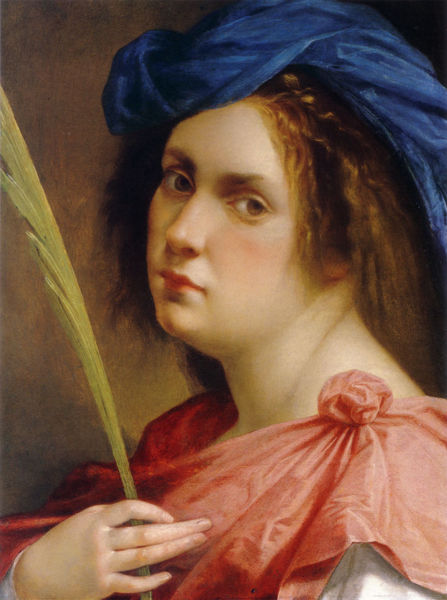
Orazio suddenly died in 1639. Artemisia had her own commissions to fulfill after her father’s death, although there are no known works assignable with certainty to this period. It is known that Artemisia had already left England by 1642, when the civil war was just starting. Nothing much is known about her subsequent movements. Historians know that in 1649 she was in Naples again, corresponding with Don Antonio Ruffo of Sicily who became her mentor and good commitment during this second Neapolitan period. The last known letter to her mentor is dated 1650 and makes clear that she was still fully active. Artemisia was once thought to have died in 1653. Recent evidence, however, has shown that she was still accepting commissions in 1654–though increasingly dependent on her assistant, Onofrio Palumbo. Thus it might be speculated that she died in the devastating plague that swept Naples in 1656 and virtually wiped out an entire generation of Neapolitan artists.
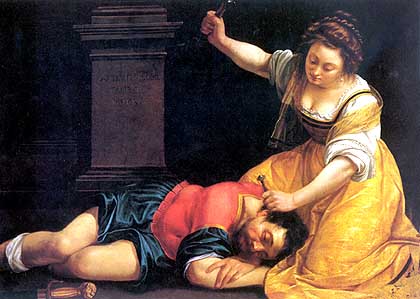
Some works in this period are Susanna e i vecchioni (Susanna and the elders) today in Brno and Madonna e Bambino con rosario (Virgin and Child with a Rosary) today in El Escorial.
A research paper of Roberto Longhi, an important Italian critic, dated 1916, named Gentileschi padre e figlia (Gentileschi father and daughter) pointed out the artistic merits of Artemisia Gentileschi in the sphere of the Caravaggeschi in the first half of the 17th century. Longhi described Artemisia as “the only woman in Italy who ever knew about painting, coloring, doughing and other fundamentals”. Longhi also wrote of Judith Slaying Holofernes:
Who could think in fact that over a sheet so candid, a so brutal and terrible massacre could happen […] but – it’s natural to say – this is a terrible woman! A woman painted all this?… there’s nothing sadic here, instead what strikes the most is the impassibility of the painter, who was even able to notice how the blood, spurting with violence, can decorate with two drops the central spurt! Incredible I tell you! And also please give Mrs. Schiattesi – the conjugal name of Artemisia – the chance to choose the hilt of the sword! At last don’t you think that the only aim of Giuditta is to move away to avoid the blood which could stain her dress? We think anyway that that is a dress of Casa Gentileschi, the finest wardrobe in the Europe during 600, after Van Dyck.

Feminist studies increased the interest towards Artemisia’s artistic work and life. Such studies underlined her suffering of rape and subsequent mistreatment, and the expressive strength of her paintings of biblical heroines, in which the women are interpreted as willing to manifest their rebellion against their condition. In a research paper from the catalogue of the exhibition “Orazio e Artemisia Gentileschi” which took place in Rome in 2001 (and after in New York), Judith W. Mann gives a feminist opinion of Artemisia:
An opinion like that presupposes that the full creative potential of Artemisia is only about strong capable women, at the point that seems impossible to imagine her busy doing conventional religious images, like a Virgin Mary with a Baby or a virgin submissively waiting for the Annunciation; and besides it is said that the artist refused to modify her personal interpretation of those subjects to conform to the preferences of a client base presumably composed by males. The stereotype caused a double restrictive effect: it both induced the critics to doubt about the attribution of the paintings not corresponding to described model, and to give an inferior value to the ones not found on the cliché.
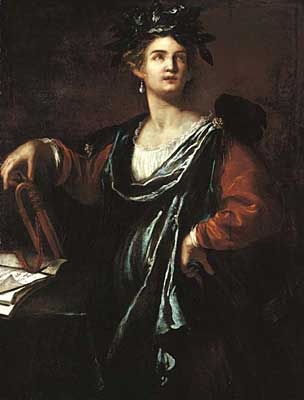
Due to the fact that Artemisia returned again and again to violent subject matter such as Judith and Holofernes, a repressed-vengeance theory is tempting. However, some art historians suggest that she was shrewdly playing on her fame from the rape trial to cater to a niche market in sexually-charged, female-dominate art for male patrons.
The most recent critic, starting from the difficult reconstruction of the entire catalogue of the Gentileschi, tried to give a less reductive reading of the career of Artemisia, placing it more accurately on the context of the different artistic environments in which the painter actively participated. A reading like this restores Artemisia as an artist who fought with determination, using the weapon of personality and of the artistic qualities, against the prejudices expressed against women painters; being able to introduce herself productively in the circle of the most respected painters of her time, embracing a series of pictorial genres which were probably more ample and varied than her paintings suggest.

Still wondering about an Italian painting in your family collection? Contact us…it could be by Artemisia Gentileschi.
Reviews
1,217 global ratings
5 Star
4 Star
3 Star
2 Star
1 Star
Your evaluation is very important to us. Thank you.
